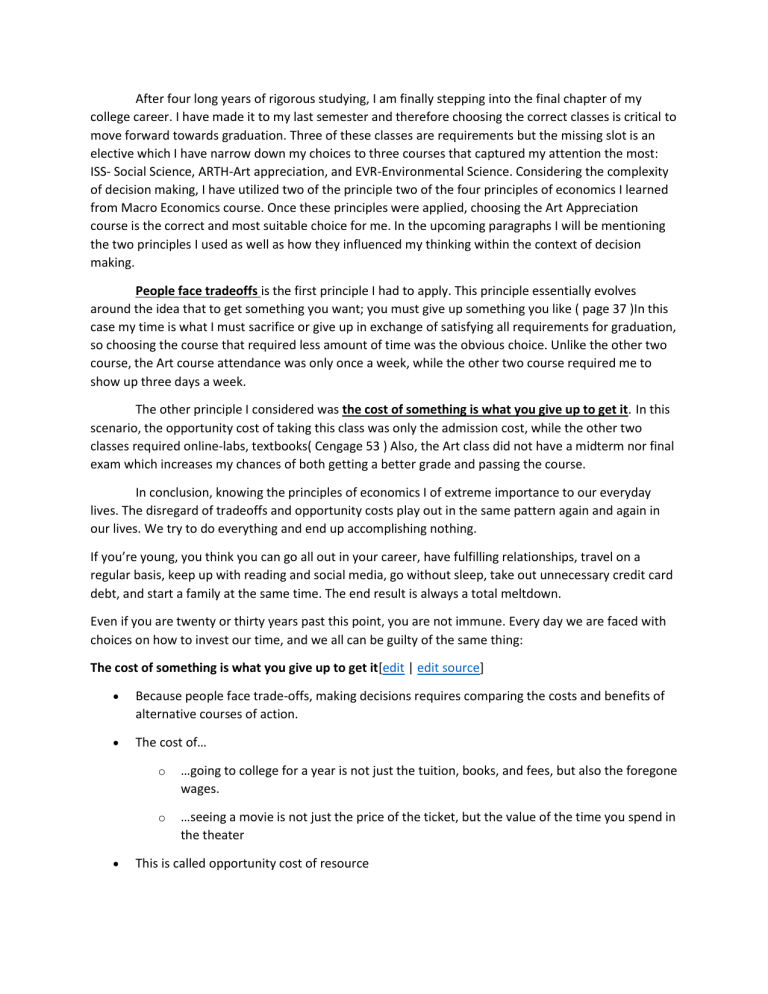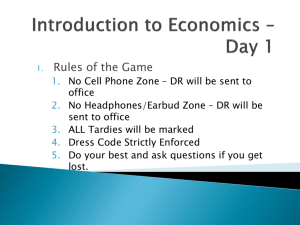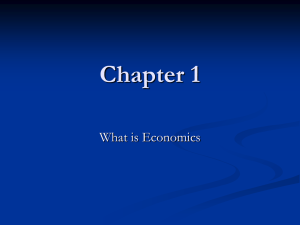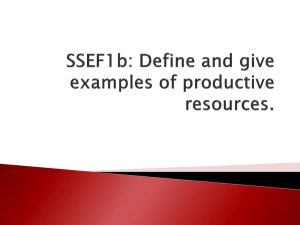
After four long years of rigorous studying, I am finally stepping into the final chapter of my college career. I have made it to my last semester and therefore choosing the correct classes is critical to move forward towards graduation. Three of these classes are requirements but the missing slot is an elective which I have narrow down my choices to three courses that captured my attention the most: ISS- Social Science, ARTH-Art appreciation, and EVR-Environmental Science. Considering the complexity of decision making, I have utilized two of the principle two of the four principles of economics I learned from Macro Economics course. Once these principles were applied, choosing the Art Appreciation course is the correct and most suitable choice for me. In the upcoming paragraphs I will be mentioning the two principles I used as well as how they influenced my thinking within the context of decision making. People face tradeoffs is the first principle I had to apply. This principle essentially evolves around the idea that to get something you want; you must give up something you like ( page 37 )In this case my time is what I must sacrifice or give up in exchange of satisfying all requirements for graduation, so choosing the course that required less amount of time was the obvious choice. Unlike the other two course, the Art course attendance was only once a week, while the other two course required me to show up three days a week. The other principle I considered was the cost of something is what you give up to get it. In this scenario, the opportunity cost of taking this class was only the admission cost, while the other two classes required online-labs, textbooks( Cengage 53 ) Also, the Art class did not have a midterm nor final exam which increases my chances of both getting a better grade and passing the course. In conclusion, knowing the principles of economics I of extreme importance to our everyday lives. The disregard of tradeoffs and opportunity costs play out in the same pattern again and again in our lives. We try to do everything and end up accomplishing nothing. If you’re young, you think you can go all out in your career, have fulfilling relationships, travel on a regular basis, keep up with reading and social media, go without sleep, take out unnecessary credit card debt, and start a family at the same time. The end result is always a total meltdown. Even if you are twenty or thirty years past this point, you are not immune. Every day we are faced with choices on how to invest our time, and we all can be guilty of the same thing: The cost of something is what you give up to get it[edit | edit source] Because people face trade-offs, making decisions requires comparing the costs and benefits of alternative courses of action. The cost of… o …going to college for a year is not just the tuition, books, and fees, but also the foregone wages. o …seeing a movie is not just the price of the ticket, but the value of the time you spend in the theater This is called opportunity cost of resource Definition of opportunity cost: whatever must be given up in order to obtain some item next best alternative forgone When making any decision, decision makers should consider the opportunity costs of each possibility. People face trade-offs “There is no such thing as a free lunch (TINSTAAFL).” Making decisions requires trading one goal for another. Examples include how students spend their time, how a family decides to spend its income, how the government spends revenue, and how regulations may protect the environment at a cost to firm owners. A special example of a trade-off is the trade-off between efficiency and equality. Definition of efficiency: the property of society getting the maximum benefits from its scarce resources. Definition of equity: the property of distributing economic prosperity fairly among the members of society. For example, tax paid by wealthy people and then distributed to poor may improve equity but lower the incentive for hard work and therefore reduce the level of output produced by our resources. This implies that the cost of this increased equality is a reduction in the efficient use of our resources. Another Example is “guns and butter”: The more we spend on national defense(guns) to protect our borders, the less we can spend on consumer goods (butter) to raise our standard of living at home. Recognizing that trade-offs exist does not indicate what decisions should or will be made.




